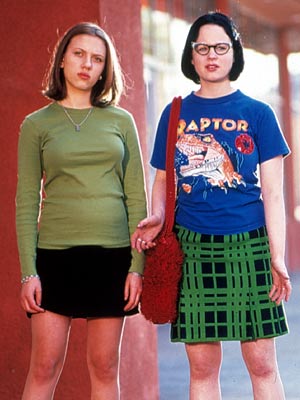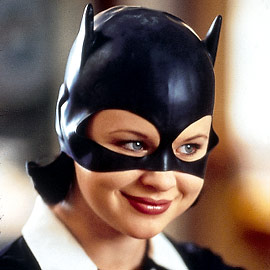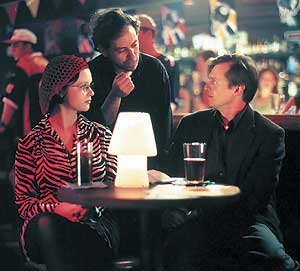
and Authenticity in Ghost World
by Doug Mann
1. Ghost World as a Critique of Consumer
Capitalism
A. From Comic to
Film
Terry Zwigoff’s 2001 film Ghost World is an adaptation of Daniel Clowes’ graphic novel of the same name (they co-wrote the
screenplay).[1] The spirit of the film is quite similar to that of the
graphic novel. In both we see the physical and existential wanderings of two
late teens, Enid and Rebecca (Thora Birch and
Scarlett Johansson), in the summer after their high school graduation in an
unnamed city that could be Clowes’ home town Chicago.
Both graphic novel and film are subtle critiques of the
effects of consumer capitalism upon our individuality and our freedom of
spirit. Yet the bleak alienation of the consumerist ghost world isn’t pictured
as a simple dead end, as some commentators has suggested, but as an arena where
our individuality is challenged and where we can choose to act authentically,
however difficult this might be.
Zwigoff’s film makes a few important changes to Clowes’
central narrative.
Yet the main change is the introduction of two entirely new
characters, one very important in understanding Zwigoff
and Clowes’ ideological intentions. Seymour (Steve Buscemi) is a middle-aged oddball who collects 78 rpm
records and is out of sorts with most of the world. He was cobbled together by
the screen writers from two minor characters in the graphic novel: a “bearded
man” who places a personal ad in the lonely hearts’ page of a local paper, and
to a lesser extent the wacky astrologist Bob Speekes,
who acts as a sort of absent guru for Enid until the final chapter “October”,
where he reappears on a cold, windy beach to do prescient psychic reading on
Enid just before she leaves town. One is tempted to also see something of Zwigoff’s old friend cartoonist Robert Crumb in Seymour,
who we know from his 1994 biopic Crumb
also obsessively collects 78s.
A second fairly significant character new to the film is
 B. Commodity
Fetishism in the Ghost World: Collectors and Shoppers
B. Commodity
Fetishism in the Ghost World: Collectors and Shoppers
To understand the nature of the “ghost world” we can turn to
director Zwigoff himself, who sees post-millennial
...just one big happy strip mall filled with Gaps and
Starbucks and Burger Kings. This is part of
So on a basic level, the ghost world is a cityscape
dominated by mass-market franchises and an ideology that tells us that meaning
can be found principally in the purchase of commodities. We are what we buy,
and there’s plenty of stuff out there to fill up our existential voids. If we
accept Marx’s diagnosis of commodity fetishism in modern capitalism as our
unholy reverence for the things we buy to the point where relations between
people turn into relations between things, then clearly the ghost world of the
film is a world full of fetishes and fetishists.
Everywhere we see shoppers and collectors: Rebecca at the homewares store,
Enid herself is a collector of dead commodities: her bedroom
is strewn with old clothes, tapes, records, toys and other assorted
bric-a-brac. She has a love/hate relationship with her “stuff,” as we see in
the garage sale scene when she refuses to sell “Goofy Gus”, a childhood doll,
and asks $500 for the dress she lost her virginity in. Indeed, her collection of commodities are central to her navigation
through the murky ghost world she sees around her toward some sense of
authenticity. Yet as we shall see, there are several ways this commodity
fetishism gets played out in the film, some less inauthentic and debiltating than others.
C. Alienation in
Ghost World: Glimpses of a McDonaldized Culture
George Ritzer has provided us with an analysis of our franchise-ridden modern consumerism than nicely dovetails onto Marx’s classical analysis of alienation. To refresh your minds: Marx argued in the 1844 Manuscripts that man under capitalism is alienated from his work, from the objects of his labour, from other workers and from his human essence, his “species being.” The Marxist analysis of alienation fits the modern service-industry workers to a tee: they are not at home when working and usually shun work like the plague, do not consume the things they make (for the most part), compete for jobs, and work in an artificial environment powered by mechanical tasks.
If we mix in some Sartrian nausea,
this sense of alienation is everywhere in Ghost
World, from Rebecca’s listless attitude toward life to
Yet part of the sadness of the film comes from the fact that
Yet this alienation isn’t just existential: it has concrete
social and economic foundations. In his famous analysis of consumer capitalism
today, Ritzer put forward the McDonaldization
Thesis, the idea that the principles of the fast-food industry - efficiency,
calculability, predictability and control over the production process - are
being applied to more and more sectors of the economy and to public
institutions such as higher education. McDonaldization,
in league with globalization, is turning real places, things, people and
services into non-places (e.g. an Internet university or fast-food restaurant),
non-things (e.g a Big Mac), non-people (e.g.
fast-food servers) and non-services (e.g. ATMs). The result of these processes
is a standardization, dehumanization, and disenchantment of social life as we
are lifted out of our historical locations into a timeless “now” of a seemingly
endless series of McDonaldized franchises and services (Mann 398).
Ritzer’s
globalized, McDonaldized economy, with its non-places and non-people, is seen
everywhere in Ghost World. Two shots
are particularly telling in this regard: one early in the film, one late. In
the first we see for a few seconds a telephoto shot of a “strip” of franchise
outlets densely packed together on a unnamed city
street, with the McDonald’s golden arches in the center. The very density of
these outlets heightens our sense of alienation. Late in the film we see
 The film also pictures a series of imaginary franchises as
McDonaldized non-places. Enid and Rebecca’s favourite
hangout is the Quality Café, with its red vinyl-covered booth seats and seeming
genuine individuality. It’s one of those unique “third places” (away from home
and work) that are quickly disappearing from North American cities. In contrast
to the Quality Café stands Wowsville, a supposedly
“authentic 50s diner” located in a mini-mall. Enid and Rebecca openly mock this
diner, sarcastically referring to a rap song playing on the table-side juke box
as a “great hit” from the 50s, speculating that they have, perhaps, gone
through a time warp. There is no hesitation in their rejection of this
“pathetic” attempt to simulate the past, though
The film also pictures a series of imaginary franchises as
McDonaldized non-places. Enid and Rebecca’s favourite
hangout is the Quality Café, with its red vinyl-covered booth seats and seeming
genuine individuality. It’s one of those unique “third places” (away from home
and work) that are quickly disappearing from North American cities. In contrast
to the Quality Café stands Wowsville, a supposedly
“authentic 50s diner” located in a mini-mall. Enid and Rebecca openly mock this
diner, sarcastically referring to a rap song playing on the table-side juke box
as a “great hit” from the 50s, speculating that they have, perhaps, gone
through a time warp. There is no hesitation in their rejection of this
“pathetic” attempt to simulate the past, though
Enid and Rebecca’s young friend Josh works at the Sidewinder
mini-mart, with its Wild West motif being yet another attempt to borrow
something real from the past to give this non-place significance. Yet as with Wowsville, no one is taking this simulation very seriously.
When
During our first visit to the Sidewinder we also get a
glimpse of American trailer-trash culture in the person of the shirtless,
beef-jerky chomping, nunchuk-brandishing Doug, who
spends a significant part of his day inside the store or playing obnoxious rock
music on his boom-box in the parking lot. Other than the playful
When Enid and Rebecca visit a “Masterpiece Video” outlet
(perhaps a mirror of Blockbuster), we see yet another picture of the
insubstantial nature of the modern McDonaldized economy. A middle-aged customer
inquires whether they have a copy of Fellini’s masterpiece 8 ½. The happy-faced young clerk asks him if this is a “new
release,” then after a few clicks on his computer cheerfully informs the movie
buff that they do indeed have 9 ½ Weeks, in
the erotic drama section. For the video store employees
film is not art, just a dehistoricized product that
they know almost nothing about but gleefully promote to their customers. They
are non-people providing a non-service to customers in a non-place. This point
is driven home when we see a chubby teenager wearing a Tommy shirt sucking on a
super-sized pop as he stares entranced at a promo for a pretentious
We also see glimpses of McDonaldization
in the two franchises
Lastly, Rebecca’s workplace of choice, The Coffee
Experience, is an obvious stand-in for the king of coffee franchises
Starbuck’s, right down to their employee uniforms with their green-and-white
logos. Like Josh at the Sidewinder, Rebecca seems to barely tolerate working
there, though by the end of the film seems to have consoled herself with being
a non-person working in an non-place. Her acceptance
of her service-industry job, and thus of the value of the ghost world,
parallels the decline of her friendship with Enid, who stays true to her
critical stance to the end.
D. A Depthless
Culture of Masks? Sperb’s Jamesonian
Analysis
In one of the few attempts to provide a cogent theoretical
analysis of Ghost World, Jason Sperb (2004) argues that Enid and Rebecca’s territory is
one filled with Baudrillard’s simulacra, with
hyperreal simulations of social life. This is the same postmodernist culture
described by Fredric Jameson as being a depthless culture of superficial images
without any historical grounding. For Sperb, Ghost World confirms Jameson’s critique
of postmodernism as a “weakening of historicity,” its detached masses
privileging “reassuring simulations over the awkward, painful confrontation of
historical depth” (217).
Sperb
sees the fact that many of the dancers and singers in the wild Bollywood musical Gumnaam Enid
watches in the opening scene are wearing masks as central to understanding the
film. The many fashion masks
Sperb
is right that we are indeed on Jamesonian territory
in Ghost World. It does picture a
culture full of McDonaldized simulacra of real services and real things, a
depthless culture of masks. Yet he’s wrong in hinting that
E. The Search for
Authenticity: Situationists, Frankfurters and
Infantile Consumers
In their book The
Rebel Sell, Joseph Heath and Andrew Potter (2004) argue that the notion of
counter-cultural consumption being more “authentic” than the mainstream’s gobbling
of Big Macs and fries is an illusion. Sandals made of hemp bought in a head
shop are just as much commodities - after all, they were manufactured to be
sold for a profit - as a pair of Nike sneakers. They are deeply skeptical that
the “rebel sell” proposed by culture jammers such as Kalle
Lasn leads to a greater authenticity. Heath and
Potter attack the Situationists and cultural jammers
for seeing mass consumption as equivalent to mass conformity. In fact,
innovation is the name of the capitalist game, and what most consumers seek is
not sameness, but distinction. We buy products that we think will distinguish
us from others in a marketplace that is competitive both economically and
culturally. They reject the entire Situationist/culture jamming ethic as a
delusion: we’re all consumers, whether we like it or not.
We can characterize the two extremes in the debate over how
the consumption of commodities affects our sense of authenticity as the
“Puritans” (e.g. the Unabomber, culture jammers), who argue that we should
reduce the consumption of mass-produced commodities to an absolute minimum if
we wish to construct a meaningful personal identity, and the “Hedonists” (e.g.
Heath and Potter, most North Americans), who argue that we can’t escape being consumers
so we may as well enjoy the ride.[4] Though the Hedonists make a strong argument in pointing out
that buying counter-cultural products is still a form of consumption, their
throwing of all “things sold” into one big pot of commodity fetishes is a gross
over-simplification, and reeks of bad faith. It also ignores aspects of life
that don’t involve the direct consumption of commodities, an area that the Situationists saw as central to the dramas of love and
poetry they sought to create.
A more fine-tuned theory of commodities is needed in order
to better understand the nature of commodity fetishism today. This theory will
show that there are three fairly distinct types of commodities, the consumption
of which leads to at least three different types of commodity fetishism. There
is also a fourth area of life that is pleasurable but doesn’t require that one
consume things. From this theory we can derive three forms of authenticity that
nicely map onto the three major characters of Ghost World: that of the infantile consumer, the Frankfurter, and
the Situationist.
2. A New Theory of Commodities
We need a more nuanced theory of the consumption of
commodities and of mass culture to interpret politically critical films such as
Ghost World, one that avoids the
extremes of cultural Puritanism and Hedonism. We can divide the “things for
sale” in our culture into three categories. They are all commodities in the
sense that we have to pay for them to legally own them, yet each category has a
quite different effect on our sense of authenticity.
(1) Basic Necessities:
These are things we need to survive on a reasonable level of well being that
aren’t advertised as specific commodities, though they might have limited
promotion in terms of competitions for lowest
price. Food and drink, non-name-brand clothes and shoes, electricity, heat,
shelter, and perhaps basic forms of communication (land-line telephones,
broadcast radio) fit this category. One never sees TV commercials trying to
convince us to “wear clothes!” or “turn your electricity on!” or “it’s a good
idea to eat food”, though we do see ads trying to sell us specific brand-name
clothes and food.
Admittedly, the line between a basic necessity and a living
commodity can be a thin one: one can legitimately ask “what’s the difference
between a plain blue sweat shirt and similar sweat shirt with a Tommy logo on
the front?” The answer is that only the latter is mass-marketed as a shortcut
to coolness for the consumer, as a way to conform to brand’s hip image and thus
find peer acceptance. Both have the use value of keeping one warm (not to
mention avoiding nudity); but the latter is a purer commodity in that its
allure is centered on its exchange and symbolic values (it costs more, and it’s
a symbol of allegiance to mainstream culture).
Commodity fetishism doesn’t really apply to basic
necessities. It’s difficult to turn socks or bananas or potatoes into fetishes,
impossible to do so with electricity, gas heat or tap water. Puritans shouldn’t
object to the consumption of such commodities as damaging to our sense of
individuality since we need such things to function as anything better than
hermits or monks in modern society. Hedonists who argue that paying one’s gas
bill or rent is the same thing as spending a day at the mall buying name-brand
fashion accessories have constructed an impossibly slippery slope from
authenticity to fakery that practically no one can avoid sliding down,
ironically mirroring the Puritan’s own extremism.
 (2) Dead Commodities:
These are things that one can buy second-hand but that are no longer
mass-produced or the subject of mass-marketing campaigns (though they might be
advertised in specialized and niche publications such as community newspapers
or fan magazines). They once were living fetishes, but are now in their retail
graves. As of the early 21st century, the following are good
examples of dead commodities: records and 8-track tapes, retro used clothes,
old books and comics, unfinished antique furniture, and black-and-white
televisions.
(2) Dead Commodities:
These are things that one can buy second-hand but that are no longer
mass-produced or the subject of mass-marketing campaigns (though they might be
advertised in specialized and niche publications such as community newspapers
or fan magazines). They once were living fetishes, but are now in their retail
graves. As of the early 21st century, the following are good
examples of dead commodities: records and 8-track tapes, retro used clothes,
old books and comics, unfinished antique furniture, and black-and-white
televisions.
As with basic necessities, the mass media spend little or no
time colonizing our inner lives to convince us to buy dead commodities for the
simple reason that they’re no longer mass produced and therefore large
corporations, which control mass-media advertising, make no profit from their
sale.[5] Of course, we do have to take into account inventories: it
may take 5-10 years after a living commodity has stopped production before it
is no longer sold as a new product and thus fades from a mass consciousness
programmed by advertising. Products most closely associated with technological
change have the shortest transitional periods: it wasn’t that long ago that
cassette tapes completely disappeared from chain music stores, almost
overnight.
Generally speaking, dead commodities are no longer consider
“cool” or “hip” except in subcultures with limited memberships. They can be
symbolically re-possessed by specific subcultures to aid in their
self-definition, as the punks did with safety pins, swastikas, hair dye and bondage gear. Yet without campaigns of mass
production and mass marketing backing them up, the consumption of dead
commodities does little damage to one’s individuality or authenticity. The
strongest conformity they call for is to the limited subcultures mentioned
above, with their obscure niche markets. Certainly a collector of such
commodities can become a fetishist. Yet such a collector can also have a
genuine intellectual or historical interest in the commodities they collect. The
buying of dead commodities doesn’t logically imply either mass conformity or a
lack of authenticity, though both depend on the buyer, the commodity itself,
and the way it is used. Obsession is still obsession, even if it involves
8-tracks. Generally speaking, the older the commodity, the greater the sense of
individuality it can generate: so 78 rpm records are more “individual” than
cassettes, 40s fedoras than 80s white sports jackets, 20s delta blues than 70s
punk rock.
The more individual the dead commodity, the less it strips its user of authenticity. For Hedonists to equate an SUV to a collection of old folk records in terms of authenticity is absurd: walk around any suburban parking lot and ask everyone getting out of their SUVs and minivans who Ewan MacColl if you want to prove this point. Since all commodities are potentially available to all consumers, the number of people who actually consume a given commodity is directly linked (contra Hedonists like Heath and Potter) to the degree of individuality that the commodity affords its consumer. If I’m the only person who treasures commodity X, then by definition I am very individual. And if I have good reasons for treasuring X, and am sincere, then I can also be seen as authentic (at least in this regard).
(3) Living
Commodities: These are mass-produced and mass-marketed commodities
advertised as specific products rather than as generic goods competing for the
lowest price. To echo Herbert Marcuse, living commodities are not basic needs:
we can survive both physically and economically without ever buying Nike
sneakers, Britney Spears CDs, Calvin Klein jeans, or Apple iPods. Living
commodities are intimately tied to the brand names that define them and the
corporate logos seen in ads for them. They are what drive the modern consumer
economy.
Culture jammers like Kalle Lasn and cultural critics like Naomi Klein mistakenly
conflate living commodities with commodities pure and simple in their critiques
of consumerism. Yet neither basic necessities nor dead commodities affect our
sense of authenticity to any where near the same degree as do living
commodities. The mass-marketing campaigns associated with them urge us to
conform to the mass perceptions of cool or the good life. If these campaigns
are successful, them millions buy the product. This is
the very definition of conformity: doing what almost everyone else is doing.
It’s also therefore the opposite of individuality.
Dead commodities have a history, while living commodities exist in an eternal present. Commodity fetishism in its purest form applies to the buying of living commodities. Thus the consumption of mass-marketed living commodities does the greatest damage to any sense of personal authenticity.
(4) Play: This is
any activity that one does freely for pleasure yet is not required for one’s
survival. Although play might require the use of a commodity, it doesn’t
involve the consumption of commodities. Play always takes place against a
background of commodities, but isn’t a commodity in itself. For instance,
playing road hockey requires that the players are relatively healthy (thus have
food, drink and clothing), and that they own a hockey stick and a ball of some
sort. Yet the actual playing of the game doesn’t cost anything. Similarly,
writing a poem requires a pen and paper, while playing a song might involve
strumming on a guitar: yet both are forms of play since the act itself doesn’t
require the consumption of a living commodity. One can write dozens of poems
with a one dollar ball point pen, hundreds of songs on a twenty-year-old
acoustic guitar. Conversely, going to Disney World might seem like a form of
play, yet the institution is a highly constructed theme park where one must pay
for an entrance ticket along with for food and drink consumed therein. It’s not
a form of play at all, but a living commodity.
Commodity fetishism definitely doesn’t apply to play since
no commodity is being paid for. As for authenticity, its very essence can be
play. Raoul Vaneigem claims
in The Revolution of Everyday Life that play is one of the three ways we can
escape from the oppressive roles foisted upon us by modern consumer society,
the other two being love and creativity.
The variety of ways we consume these three types of
commodities generate at least three distinct attitudes and thus three distinct
types of authenticity: that of the mainstream infantile consumer, the critical
though largely passive adherent to the tenets of the
In his book Consumed (2007),
Benjamin Barber lays out nicely the ideological mindset of the Hedonist
consumer today. The goal of consumer capitalism is to encourage impetuous
consumption by prolonging childhood in children and re-awakening it in adults.
It thus promotes an infantile ethos which values the easy over the hard, the
simple over the complex, the fast over the slow, feeling over reason, the individual over the community, and play over work.
Barber provides plenty of examples of the infantile ethos in operation: lying
politicians, cheating students, fast food, dumb movies, soft news (“the Fox
effect”), instant messaging, the popularity of video
games. In fact, it actually co-opts play itself, turning it into a commodity
that we have to work hard most of the year to be able to enjoy. The infantile
consumer, who revels in living commodities, dominates sociologically our North
American culture today.
A consumer of living necessities who also enjoys one or more
dead commodities can be seen as a “Frankfurter” who rejects current
mass-marketing campaigns and conformist images of cool in favour
of half-forgotten past cultures. A third position on commodity consumption is
that of the Situationist, who tries to actively disrupt these campaigns and
images of cool through the creation of situations, psychogeographic
wanderings, and détournement.[6]
3.
A. Enid and
Rebecca’s Situations and Derivés
In Ghost World,
Yet the most obvious echo of Situationism in
Debord
(1958) defines a dérive as “a technique of rapid passage
through varied ambiances” which involves “playful-constructive behavior and
awareness of psychogeographical effects” where:
...one or more persons during a certain period drop their
relations, their work and leisure activities, and all their other usual motives
for movement and action, and let themselves be drawn by the attractions of the
terrain and the encounters they find there.
They drift through a city, soaking up the atmosphere,
creating situations that cut through consumer conformity. Throughout Ghost World
We see a sort of situation in the very first sequence of the
film, where Thora Birch’s Enid dances joyfully to a
video of a 1960s Bollywood musical clad in her red
graduation gown, in striking contrast to the windows of boredom through which
we see her neighbours: a sad smoker, a jaded family
watching TV, a man mechanically eating by himself. Soon after her victory dance
we see Enid and Rebecca stomp on their graduation miter-board hats in their Doc
Martens, saying goodbye to high school and all its social roles.
Later, when
In a third situation at the faux-fifties diner Wowsville, Enid
concocts the plan to answer what turns out to be Seymour’s personal ad to a
“striking blonde” in a yellow dress who he ran into at the airport. She later
phones
A couple of
A final constructed situation stands out: when
Despite disappointing outcomes of some of her actions,
 B. Fashion and Style
as Détournement: Enid’s Many Masks
B. Fashion and Style
as Détournement: Enid’s Many Masks
In Ghost World, Enid
uses changes in fashion and style - both sartorial and musical - as détournements, as attempts to both reject mainstream
social roles and to redefine her cultural environment according to her own
playfully critical mindset.[8] Many of
The most obvious détournements we
see in the film are
!Schoolgirl
Persona: white shirt with Catholic school tie, burgundy sweater, red hair band
(a seen when she attends her art class).
!Anti-Fashion
“Bricoleur” Persona: Green liptstick,
brown nail polish, “recycled” shirt, black skirt (when she attends
!Punk
Look (circa 1977): Green hair, black leather jacket, black pants, black boots.
!Nautical
Motif: A blue “sailor” dress with wire-rim glasses (seen in the college
hangout).
!Tiger
Lady: A black and white dress with tiger stripes topped off with a red fishnet
cap (seen in the blues bar).
!Sexy
Seductress: A bright red shirt, lipstick, a black skirt and fishnet stockings
(seen when she tries to convince
!Corporate
Slave: Yellow and black Pacific Theaters uniform.
As mentioned before,
C. Refusing Roles and the Spectacle: Enid’s Search for Authenticity
Raoul
Vangeigem saw roles as “nuclei of alienation embedded
in the flesh of everyday experience” which act as “bloodsuckers of the will to live” (Vaneigem in Mann 129). Roles force us to sublimate our
erotic energies: they’re like medieval suits of armour
that simultaneously restrict our freedom of movement while also deadening the
blows of our enemies. They protect us from real life.
John Ellis and his friends at Zine-o-Phobia
represent “alt” youth culture, which Zwigoff and Clowes clearly see as uncritical and conformist. This becomes clear when
Ellis tells Enid that he intends to go to business school and "fuck things
up" from within. As
Her hasty retreat from the magazine store leads her home to
another dye job (this time back to black) and to a key revelation. As she works
on her hair

We get another glimpse of alt youth culture at the college
café
Her rejection of alt culture is also hinted at during her
garage sale, which shows
Another key rejection of roles by
A final picture of authenticity comes when
 4. Rebecca as
Convert to Infantile Consumerism
4. Rebecca as
Convert to Infantile Consumerism
Rebecca starts out the film as
Rebecca’s shift from being
Rebecca wants to at least wear the masks of mainstream roles from fairly early on, suggesting that she
and Enid buy “semi-expensive outfits” so they look like “totally rich yuppies”
during their apartment-hunting campaign. She accepts her impressment
into the the McDonaldized service economy,
specifically, her job at the psuedo-Starbuckian café
The Coffee Experience. While at work she makes clear that she rejects Enid’s
celebration of outsiders when she tells her that “you get tired of all the
creeps and losers and weirdoes,” preferring her regular customers, who at least
in the screenplay are portrayed as well groomed yuppies grabbing a quick
cappuccino before running off to work. She also accepts mainstream definitions
of roles based on age, sexuality, and fashion, seeing the young men in the
college café as sexually desirable, wanting to take up the alt rock guy’s offer
of free entry to Alien Autopsy’s concert. She simply doesn’t understand
By the time she’s rented an apartment, she’s also bought
into the need to fill her life with living commodities to give it meaning. In a
scene at a house wares big box store we see Rebecca insist that they need to
“start getting stuff” in preparation for their move, even offering to pay for
it herself since
 5.
5.
Not counting the phony date
We get a glimpse into the subculture of record collectors at
the “party”
Yet the key moment for understanding
A final glimpse of how
 6. Dana and Roberta
as Variations on a Consumerist Theme
6. Dana and Roberta
as Variations on a Consumerist Theme
A pair of relatively
minor characters provide us with two more
positions on commodity consumption and authenticity. Dana is the mysterious
blonde who
When
Lastly,
7. Leaving the Ghost
World
As we’ve seen, Ghost
World presents a triad of major positions on the relation between commodity
consumption and authenticity:
In the last scene in the film, which is lifted straight from
the graphic novel,
Ghost
World (2001).
Directed by Terry Zwigoff. Written by Daniel Clowes and Terry Zwigoff. MGM.
The Corporation (2003).
Directed by Mark Achbar and
Jennifer Abbott. Written by Joel Bakan.
Clowes, Daniel and Terry Zwigoff
(2001). Screenplay for Ghost World. Screenplays for You, http://sfy.ru/sfy.html?script=ghost_world.
Clowes,
Daniel (1998). Ghost
World.
Barber, Benjamin (2007). Consumed: How Markets Corrupt Children,
Infantilize Adults, and Swallow Citizens Whole.
Debord,
Guy (1958). “Theory of the Dérive.”
Internationale Situationniste
#2 (December). Trans. Ken Knabb. http://www.cddc.vt.edu/sionline/si/theory.html
Debord, Guy (1967, trans. 1977). The
Society of the Spectacle. Trans. Fredy Perlman. Red & Black. http://library.nothingness.org/articles/SI/en/pub_contents/4
Heath, Joseph and Andrew Potter (2004). The
Rebel Sell.
Mann,
Olsen, Mark (2001). “Long Live the Losers.” Film Comment 37: 30-32.
Ritzer, George (2000). The
McDonaldization of Society. Revised New Century
edition.
Ritzer, George (2004). The
Globalization of Nothing.
Sperb,
Jason (2004). “Ghost without a Machine:
Vaneigem, Raoul
(1967, trans. 1972). The Revolution of Everyday Life. Red & Black.
http://library.nothingness.org/articles/SI/all/pub_info/5
Zwigoff,
Terry (2001). MGM Online Interview. http://www.ghostworld-the-move.com/ie/index.html